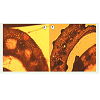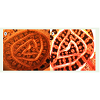Research Article
Impact of Heavy Metal Cadmium on LeafPhysiology of Grass (Sedges)
Pritesh Parmar, Ketankumar Panchal, Khushbu Raj, R.B. Subramanian*
B R D School of Biosciences, Sardar Patel University, VallbhVidya Nagar- (Gujarat), India
Corresponding author: RB Subramanian, B R D School of Biosciences, Sardar Patel University, Post Box no. 39, Vallbh VidyaNagar- 388120 (Gujarat) India. Tel.:+91-2692-234402/234412, Fax: +91-2692-236475/237258; E-mail: asp.fus@gmail.com
Citation: Parmar P, Panchal K, Raj K, Subramanian RB. Impact of Heavy Metal Cadmium on Leaf Physiology of Grass (Sedges) . J Chem AppliedBiochem. 2015;2(1): 115.
Copyright © 2015 Subramanian RB et al. This is an open access article distributed under the Creative Commons Attribution License, which permits unrestricted use, distribution, and reproduction in any medium, provided the original work is properly cited.
Submission: 06/06/2015; Accepted: 29/10/2015; Published: 04/11/2015
Abstract
Remediation of heavy metal is crucial which can be efficiently achieved by biological treatment compared to chemical and physico-chemical techniques. Thebest among the biological is application of plants for the uptake of heavy metals from contaminated sites though it has certain limitation but it is economicaland environmental safe technique. In order to apply, it is critical to identify the hyperaccumulator plant amongst the population in terms of heavy metalsuptake, the present study reconfirms the finding of the grass as a hyperaccumulator by anatomical changes pertaining the heavy metal stress. Anatomicalchanges can be applied to identify hyperaccumulator at preliminary stage but it needs to be confirmed by metal localization or metal uptake study.
Keywords: Sedges; Starch granules; Vascular bundle
Introduction
The contamination of the environment by toxic metals posesa threat for “Man and Biosphere”, dropping agricultural yield anddetrimental to the health of ecosystem. Heavy metal pollution isa serious threat to both man and plants. Living organisms havedeveloped a variety of mechanisms to counteract the toxic effectsof heavy metal ions [1]. In order to maintain the concentration ofessential metals within the physiological limits and to minimizethe detrimental effect of nonessential metals, plants like all otherorganisms, comprise a composite system of homeostatic mechanismsthat provide to manage the uptake, buildup, transport anddetoxification of metals.
Uptake and accumulation of heavy metals at higherconcentration can be cytotoxic in some plants species, causingstructural and ultrastructural changes affecting the growth andphysiological well being of the plants [2,3].
The phytotoxic effect of heavy metals in plants manifests itselfthrough visual symptoms such as wilting and reduced augmentationand biomass accumulation [4,5]. Physiological changes have also been noted in plants exposed to contamination at various levels ofthe photosynthetic process, including the chlorophyll biosynthesis[6], the consequences of photochemical reaction [7] and the action ofCalvin cycle enzymes [8].
In this study anatomy of the grass leaves in terms of starchcontent and vascular bundle was observed to check the consequencesof the heavy metal cadmium stress in leaves which reconfirms that itis a hyperaccumulator.
Materials and Methods
Plant sample
Mature sedge (grass) which was reported as a hyperaccumulatorby Parmar et al. [9], taken for the study of anatomical differentiationafter two months of treatment with 100 mM cadmium nitrate.
Free hand sectioning
A new double edge razor blade was rinsed with warm tap waterto remove traces of grease from the surface of the blade. The plantmaterial was hold firmly for sectioning and razor blade floodedwith tap water to minimize the friction was drowned at right angle to and fro across the top of the material. Several sections were cutat a time which varied in thickness. The thinnest sections (the moretransparent ones) were selected and transfer sections on a glass slideusing a brush.
For delicate and hard to hold specimens such as thin leaves andtiny roots, additional support such as potato slice was used to facilitatehand sectioning. Tissue pieces were inserted in between potato slice.Once the tissue was firmly in place, the hand section was taken asdescribe above.
Micro morphological changes (Vascular bundle)
Sections were placed on a clean glass slide and flooded with anaqueous solution of 0.2 % safranin solution for one minute. Stainwas then removed by flooding the sections with tap water, washingwith tape water was repeated number of times till there was no excessstain around the sections. A drop of clean water over the sections wasapplied and a cover glass was placed on it to mount the section underlight microscope.
Starch content
A drop of IKI solution was positioned directly on the section anda cover glass was mounted and observed under the light microscope.
Results
Anatomical response
Vascular bundle: Observation of the safranin stained transversesections of control and treated leaves after two months of heavymetals stress under light microscope showed significant changes inthe number of the vascular bundles. The number of vascular bundlesin the leaves of control plant ranged from 45-46 while in metal treatedplants it was from 51-52. The width of vascular bundles also showeda change in size from 4-12 μm in control plant and 3-9 μm in treatedplants as shown in Figure 1.
Starch content: Evaluation of starch content under heavy metalstress using IKI stain, revealed increase in the starch content in treatedplant compared to the control plant as shown in Figure 2.
Discussion
Gomes et al. [10] observed that the number of trachearyelements in the vascular bundle was less in the plants exposed to high concentrations of heavy metal. The area of metaxylem elements wassmaller in the treatment by 15%. In the present investigation also adecrease in vessel size accompanied by an increase in the numberof vascular bundles was observed in treated plants compared to theuntreated plants. Reduction in the number of conducting elementshas been reported in literature as being an adaptive measure tosecure water flow [11]. Reduction in size and number of conductingelements of the xylem in response to heavy metals has been reportedby Sandalio et al. [12].
Moya et al. [13] performed experiments on rice plants that weregrown 5 or 10 days in a nutrient solution with Nickel (0.1 and 0.5mM). Nickel reduced carbohydrate transport by inhibition of starchconversion into sucrose, and its translocation to the roots resultinginto reduced carbohydrate supply for roots and in consequencedepressed mitotic activity in root meristems. In the present studytoo, the starch content in the leaves of Sedges showed an increase intreated plant than in control. However, the above results are not inagreement with the findings of Espen et al. [14,15] who suggestedthat increased concentration of Nickel in radish seedlings stronglyaffected reactivation of oxygen uptake and increased the energychange, the transportation of sugar, phosphor-organic compounds,and inhibited the synthesis of DNA, RNA and protein of soluble andmicrosomal fractions.
References
- Cobbett C, Goldsbrough P (2002) Phytochelatins and metallothionein: roles in heavy metal detoxification and homeostasis. Annu Rev Plant Biol 53: 159-182.
- Han FX, Maruthi Sridhar BB, Monts DL, Su Y (2004) Phytoavailability and toxicity of trivalent and hexavalent chromium to Brassica juncea. New Phytol 162: 489-499.
- Zhao FJ, Lombi E, Breedon T, McGrath SP (2000) Zinc hyperaccumulation and cellular distribution in Arabidopsis halleri. Plant Cell Environ 23: 507-514.
- Marques TCLLSM, Moreira FM, Siqueira JO (2000) Growth and uptake of metals in tree seedlings in soil contaminated with heavy metals. Pesquisa Agropecuária Brasileira 35: 121-132.
- Sanita di Troppi L, Gabbrielli R (1999) Response to cadmium in higher plants. Environ Exp Bot 41: 105-130.
- Chugh LK, Sawhney SK (1999) Photosynthetic activities of Pisum sativum seedlings grown in presence of cadmium. Plant Physiol Biochem 37: 297-303.
- Skorzynska-Polit E, Drazkiewicz M, Krupa Z (2003). The activity of the antioxidative system in cadmium treated Arabidopsis thaliana. Biologia Plantarum 47: 71-78.
- Cagno R, Guidi L, Stefani A, Soldatini GF (1999) Effects of cadmium on growth of Helianthus annuus seedlings: physiological aspects. New Phytologist 144: 65-71.
- Parmar PP, Dave B, Panchal K, Subramanian RB (2013) Screening of potential species Croton bonplandianum, sedges and Balanitis aegyptica for the application of phytoremediation. American journal of plant sciences 4: 1246-1251.
- Gomes MP, de Sá e Melo Marques TCLL, Gonçalves Nogueira MO, de Castro EM, Maria Soares A (2011) Ecophysiological and anatomical changes due to uptake and accumulation of heavy metal in Brachiaria decumbens. Sci. Agric. (Piracicaba, Braz.) 68: 566-573.
- Baas P, Werker E, Fahn A (1983) Some ecological trends in vessel characters. IAWA Bull 4: 141-159.
- Sandalio LM, Dalurzo HC, Gómes M, Romero-Puertas MC, et al. (2001) Cadmium-induced changes in the growth and oxidative metabolism of pea plants. J Exp Bot 52: 2115-2126.
- Moya JL, Ros R, Picazo I (1993) Influence of cadmium and nickel on growth, net photosynthesis and carbohydrate distribution in rice plants. Phtosynth Res 36: 75-80.
- Espen L, Pirovano L, Sergio MC (1997) Effect of Ni2+ during the early phase of radish (Raphanus sativus) seed germination. Environ Exp Bot 38: 187-197.
- Nedelkoska TV, Doran PM (2000) Hyperaccumulation of cadmium by hairy roots of Thlaspi caerulescens. Biotechnol Bioeng 67: 607-615.


